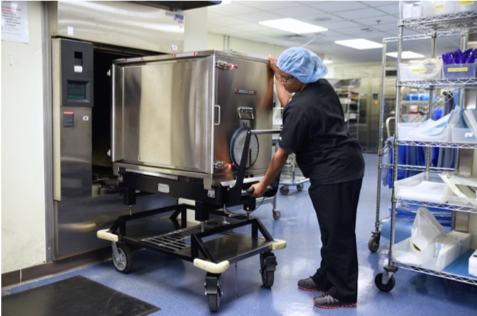
(The SteriCUBE Insight Series seeks to provide frontline perspectives on multi-tray sterilization technology that is changing the way medical devices are processed and how patient safety is promoted in hospitals and surgery centers around the country. The views expressed are the sole opinion of the author and in no way reflect the position of any employer, facility, or vendor.)
Author: Mathew Scheftner, CHL, CRCST, CER – System Manager of Sterile Processing for St. Joseph’s|Candler
Many new technologies in the Sterile Processing and Operating Room space can make us nervous, and cause us to question everything we’ve previously learned about a process or workflow. Multi-tray sterilization technology is a great example of one of those concepts that pushes back against the traditional “norms.” There are a number of reasons that this technology is worth embracing, but this article will address its impact in overcoming the challenges of instrument turnovers in particular.
Handling Turnovers with Speed
Multi-tray sterilization brings a tremendous advantage to the overall turnover process. For example, if we have a surgeon that has five sets of Total Knee Arthroplasty (TKA) instruments, we may need to turnover an entire set-up for the fifth case because it’s a double revision set-up. With multi-tray sterilization technology, the turnover process becomes much easier. You are able to process each tray as you normally would through the cleaning and assembly process, and then place each tray directly inside the multi-tray unit – basically a giant rigid container. No pans or wrap needed.
Our current units can process up to twelve full-size sets in a single load, even though we usually process nine. Imagine being able to process nine loaners and completely skip the wrap process, no corner protectors, no lint free towels, no wrap, no tape – it’s awesome. This has a real impact, not only on the speed of the turnover process, but also on the consumable supply budget. It makes processing loaners easily twice as quick – with far less waste.
A Streamlined Turnover Workflow
When a TKA set-up turnover comes through the washers, it’s all hands on deck in Sterile Processing. Everyone scans their own tray and helps to load the multi-tray sterilization unit. At my orthopedic hospital, for instance, we process an average of 3-5 units a day, saving us from wrapping up to 25-35+ loaners on any given night. The units are prepped with new filters and locks immediately prior to the loading process to ensure that last level of quality assurance before we move to the sterilization stage.
One person is definitely able to manage the set up and loading of the unit. However, for quality assurance at our hospital, we designed the quality check for a two person sign-off. The primary technician sets up the unit and the secondary team member quality checks their work.
After the units are used in the OR and decontaminated in our department, we wipe them down and cover them with a large bag to protect against any potential dust accumulating on them. At that point, they are usually tucked off to the side in the corner of the department.
The Biggest Helps and Biggest Hurdles
It’s difficult to overstate how much of a crowd-pleaser multi-tray sterilization is in our department. The Operating Room team would rather pull from a single container unit than have to open up and inspect nine separate loaners wraps or deal with nine individual containers. With less time being spent processing loaners, it allows more time for all of us to focus on other important requirements of our jobs.
The biggest hurdle to multi-tray sterilization is definitely competency – and ensuring that every vendor, SPD, and OR staff member understands the impact this technology will have on our workflows. Vendors have to understand and properly communicate which trays they are checking in for which patients, since the trays are set up as complete cases.
For Sterile Processing, competency boils down to really understanding the different filters, tray placement, locks and aseptic technique of these devices. It’s critical for SPD to set the filters correctly, as well as place the trays in the unit in a way that the OR can easily remove them from the unit in an aseptic manner. Even something as simple as closing and locking these units has its own level of importance to ensure proper sterility is maintained. If SPD doesn’t ensure their side of the process is flawless, it sets our partners in the OR up for failure.
Finally, it’s the responsibility of the Operating Room to assure that all filters and locks remained in place during processing and transport of the device, and that there are no quality compromises, such as holes or wrinkles in the filters, at the point of use. Once the trays have been removed and the unit is cleared for use, it is then removed from the room and delivered back to SPD for cleaning and storage until the next use.
Understanding the impact that multi-tray sterilization technology has had on our instrument turnover workflow has changed the way we think about speed, efficiency, and staff competencies. Perhaps it will change your mind as well.


